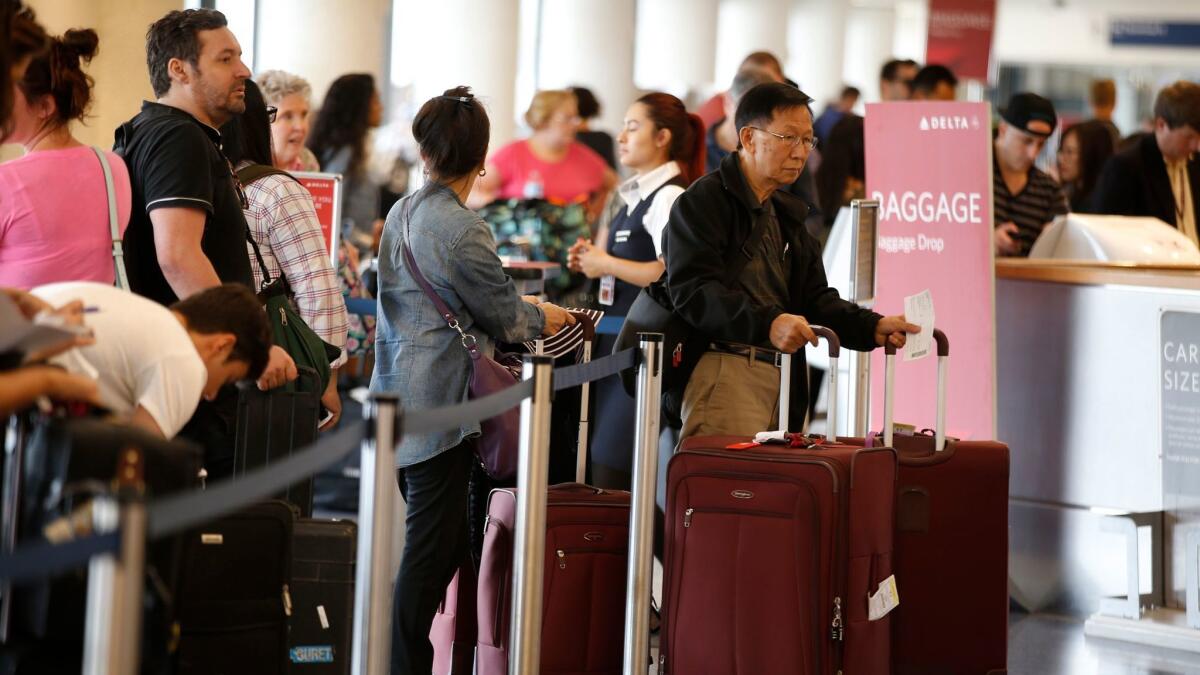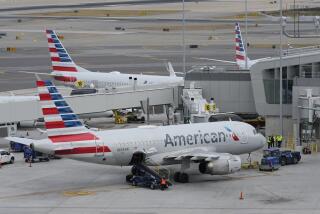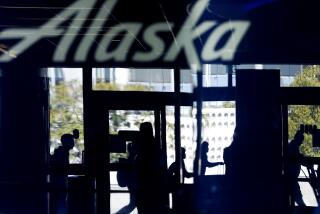Frequent flier programs generate profits for airlines and frustration for travelers

Alaska Airlines employees have long received bonuses for helping reach on-time arrival goals and improve passenger satisfaction scores. And they recently got a new way to earn a pay bump: If more travelers sign up for the carrier’s frequent flier pr
Alaska Airlines employees have long received bonuses for helping reach on-time arrival goals and improve passenger satisfaction scores. And they recently got a new way to earn a pay bump: If more travelers sign up for the carrier’s frequent flier program.
For good reason. Airline loyalty programs, which began nearly 40 years ago as a promotional gimmick, are becoming increasingly lucrative for carriers.
Such programs can bring in as much money as all those fees that passengers complain about, including charges for checked bags and onboard food and drinks. Some analysts estimate that as much as half of all airline profits come from frequent flier programs.
But the programs are a growing source of frustration for airline passengers.
In the last few years, most airlines have dramatically overhauled their frequent flier programs. The latest is United Airlines, which as of Nov. 1 will require more mileage points to fly some of its most popular routes.
For many fliers, the industrywide changes have sharply reduced the value of reward points and made them harder to redeem.
Passengers view these points as something they have earned.
— Paul Hudson, president, FlyersRights.org
Samuel Engel, head of aviation at the management consultant ICF, compared the devaluation of frequent flier reward miles to extreme inflation.
“It really looks like the hyper-inflation of Zimbabwe or Venezuela,” he said.
Kerry Welsh, a retired entrepreneur from Rancho Palos Verdes, is a member of several airlines’ frequent flier programs but said he is frustrated by the extra cost and lack of available seats when he tries to redeem his miles.
“Many frequent fliers are like me,” he said. “We have millions of miles, but we don’t use them, because using the miles is a big rip-off. So instead we accumulate more miles.”
American Airlines launched what many consider to be the first airline loyalty program in 1982.
Since then, the programs have surged in membership and revenues thanks to mergers and acquisitions in the last few decades that created a handful of giant carriers that dominate the industry.
American Airlines’ AAdvantage program is now the world’s largest frequent flier program, with about 100 million members.
The program generated $2.1 billion in revenue last year, and accounted for much of the 3.9% growth in “other revenue” not derived from carrying passengers and cargo, according to the airline. During the same period, overall revenue fell 2% to $40.2 billion.

It is difficult to gauge the exact value of the loyalty programs because airline executives won’t discuss the deals they have signed with the banks and credit card companies that buy and distribute the airline miles to reward program members.
In earnings reports, airlines combine revenue from frequent flier programs with other funds under categories titled “other revenue” or “ancillary.”
When United Airlines filed for bankruptcy in 2002, it was forced to disclose that its mileage program at the time posted profit margins as high as 45%. Since the airline emerged from bankruptcy, United has stopped reporting such financial details.
Jay Sorensen, president of IdeaWorks Co., a consultant on boosting airline revenue, called frequent flier programs a “tremendous cash cow” for the airlines.
In a recent report, Sorensen estimated that the nation’s top four airlines — American, United, Delta and Southwest — generated a combined $9.5 billion in revenue last year from frequent flier programs.
“The programs have a huge impact on the bottom line for airlines,” he said. “They simply can’t do without them.”
Frequent flier members earn reward miles or points either by flying or by spending with a credit card that has partnered with an airline. The miles or points can be redeemed for airline tickets or for seat upgrades, and airlines dictate the value of the miles or points.
Sometimes airlines devalue the miles with little warning to members, and many now vary the rewards based on demand.
A study by financial research site WalletHub found that six of 10 U.S. airlines’ reward programs lost value for members in 2017 compared with the year before.
Hawaiian, Alaska and Virgin America airlines increased the rewards value by an average of 40%, while Delta was unchanged. American, United, Southwest, JetBlue, Frontier and Spirit all reduced the value of points passengers could earn.
Starting Nov. 1, United is changing its rewards program so that on some popular domestic routes a one-way ticket would require up to 32,500 miles to redeem, up from 25,000 miles now.
Flyersrights.org, a passenger rights group, has lobbied Congress to adopt legislation to give passengers “reasonable” warning before miles or points are devalued.
“Passengers view these points as something they have earned,” said Paul Hudson, president of the group.
Frequent flier programs are hugely profitable because airlines charge credit card companies up to three times more for the miles or points than it costs the carriers to redeem them, according to estimates by industry experts.
And when the mile rewards expire or go unused, the airlines can pocket the revenue without the expense of flying the frequent flier member anywhere. At least 15% of all reward miles expire without being used, industry experts say.
Also, some airlines don’t make it easy to redeem the reward miles for seats on a flight.
At American Airlines, the world’s largest carrier, seats are available for redemption by frequent flier members only 54% of the time, according to a study by Sorensen. Redeeming seats on long-haul flights is even more difficult, the report said.
In a statement, American Airlines said it works to “ensure our best customers have the best access and experience that American and AAdvantage have to offer. All of our changes are structured around this thought.”

Frequent flier programs are so profitable they can help an airline overcome strong financial head winds.
In the three months that ended June 30, Delta Air Lines reported a highly profitable quarter despite foul weather at the carrier’s Atlanta hub. The airline has a partnership with American Express, which doles out reward miles to card holders for spending on flights or other expenses.
“Our partnership with American Express produced $70 million of incremental value this quarter, and we are on pace to deliver $300 million of incremental value in 2017, including another record year for card acquisitions,” Delta President Glen W. Hauenstein said in a conference call with analysts.
Alaska Airlines puts so much value in the growth of its Alaska Mileage Plan that it tied pay increases to the growth of the enrollment of the Alaska Mileage Plan and the increase in customers who have an Alaska Airlines Visa Signature credit card. The airline said workers could get a 0.5% pay increase if it reaches its growth target, which the airline declined to disclose.
Airline critics say loyalty program profit has come at a cost to frequent flier members.
Since 2011, the four biggest airlines have revamped their programs to base rewards on total dollars spent — not miles traveled. The change means more reward points for high-spending elite-class travelers while fewer are given to economy-class fliers.
A study by Boston flight research site Hopper.com found that United fliers get 11% fewer reward points and Delta passengers earn 22% fewer miles under the dollar-based system.
Engel noted that airlines have regularly increased the number of reward miles needed to book a flight, with little notice, and added new restrictions for redeeming the miles. The constant changes and limits can make using rewards confusing.
“When you devalue the points, you degrade the trust with the customer,” he said.
Jamie Moran, a therapist from Menlo Park and frequent flier program member with United Airlines, said that after the overhaul of the United frequent flier program in 2015 he collected about 66% fewer miles per flight than he did before the change.
“This accrual is extremely slow, and I am really disappointed,” he said.
But Jason Womack, an author and member of American’s AAdvantage program, said he can still redeem his miles for trips as long as he is flexible with his schedule.
“If I look out at the calendar and am willing to think about the next 90 to 180 days,” he said, “I can generally book a trip using miles.”
To read more about the travel and tourism industries, follow @hugomartin on Twitter.
ALSO
Hurricane Irma forces cruise lines to shorten some trips and cancel others
Motel 6 says its employees will no longer call immigration agents on its guests
Examples of ‘price gouging’ during Hurricane Irma were aberrations, airlines say







